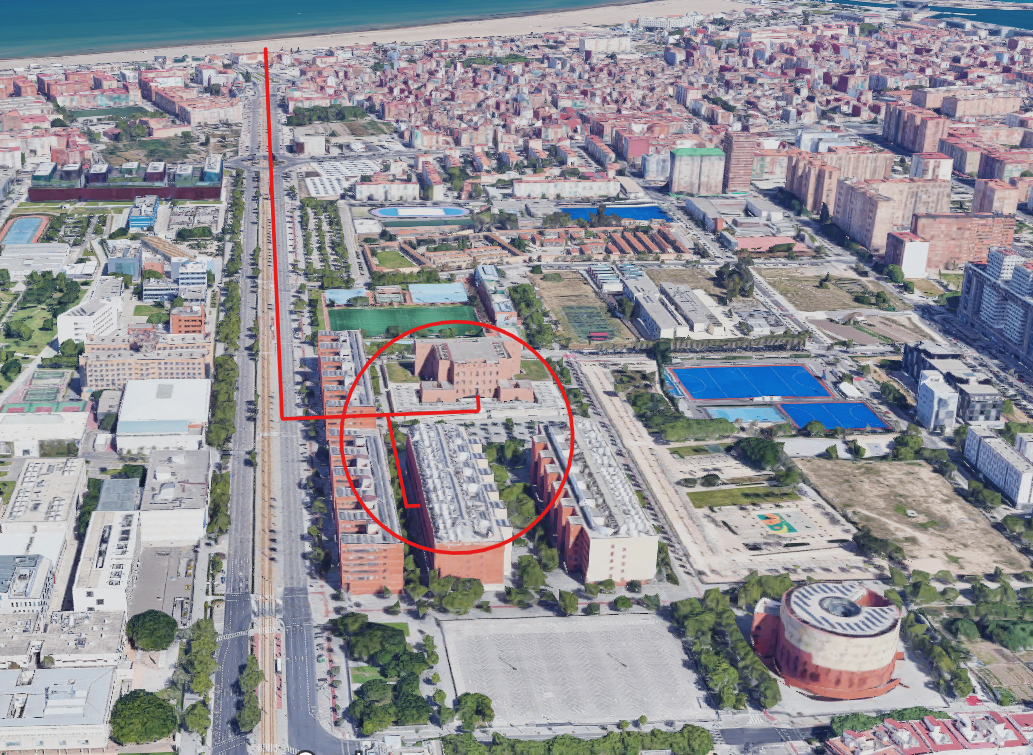Thematic sessions | Call for papers | Theme | Programme | Registration | Travel Information | Publications | Organisation | Other languages |
ACCOMMODATION: There are plenty of hotels and tourist apartments in Valencia.
University residences are also a good alternative as for example the Halls of Residences:
Damià Bonet or Galileo Galilei, within 1 minute walking distance from the congress.
INTERNET: Access to the wireless eduoroam network will be provided.
TOURISM: You can find information about the general events and activities in Valencia on the following websites:
More details and suggestions will be provided by the organisers in Valencia.

The plenary sessions will take place in the north lecture hall of the Tarongers Campus of the University of Valencia (Av. Tarongers).
The keynote speeches will take place in the assembly hall of the Gregori Maians Library on the same campus.
Coming to the venue:
PLANE: Valencia Airport is located in the nearby town of Manises, about 8 km away from the city. Flights arriving from major Spanish and European cities land there. Furthermore, Valencia connects with destinations all over the world through Madrid and Barcelona. From that spot, you can take a taxi or the underground.
- TAXI: You can catch a taxi from Manises to the University; the journey takes about 25 minutes and costs about 25 Euros.
- UNDERGROUND: At the airport you can take line 3 (heading to Rafelbunyol), get off at the Benimaclet stop and switch to line 4 (heading to Doctor Lluch). The third stop (La Carrasca) leaves you exactly in front of the congress venue.
TRAIN: Valencia has two train stations that are quite close, with different routes: Joaquín Sorolla Station and Valencia North Train Station. Joaquín Sorolla station has the following long-distance routes: Madrid, Barcelona, Alicante, Castellón and Albacete. The rest of long-distance, middle-distance and suburban routes leave from Valencia North Train Station. The distance between the two stations can be covered on foot in 10 minutes or by an exclusive Renfe bus. It is free if you show the ticket of the train. Both stations are located in the middle of the city.
From the Estación del Norte train station you can take a taxi, a bus or the underground.
- TAXI: You can catch a taxi from both stations to the University; the journey takes about 15 minutes and costs about 12 Euros.
- SUBURBBAN BUS: From Joaquín Sorolla station you can take the bus number 9 to go to the congress venue. The stop is on San Vicente Mártir Street. And, from the North Train Station, you can take number 40. The stop is on Alicante Street.
- UNDERGROUND: Opposite the Valencia-Norte train station is the Xàtiva metro stop. From there, you must take line 3 (heading to Rafelbunyol or Alboraya-Peris Aragó), get off at the fourth stop (Benimaclet stop) and switch to line 4 (heading to Doctor Lluch). The third stop (La Carrasca) leaves you exactly in front of the congress venue.
Precautions against heat and sun exposure in Valencia:
To avoid suffering adverse consequences from prolonged exposure to the sun and high temperatures during your stay in Valencia, it is important to take into account the following recommendations:
- To avoid dehydration, it's important to drink water and fluids frequently, even if you don't feel thirsty and regardless of how physically active you are. Do not abuse drinks with caffeine, alcohol, or large amounts of sugar, as they can make you lose more body fluid.
- Use sun protection products with a high factor and suitable for your age, skin type, and area of the body. These protectors should be applied, in generous amounts, 30 minutes before exposing yourself to the sun and renewed every two hours and after each bath. Remember that even highly effective sunscreen products that protect against both UVB and UVA radiation cannot guarantee full protection against the health risks that ultraviolet radiation poses. The only way to completely avoid sun damage is to avoid exposure and, when this is not done, take the appropriate protective measures described to try to reduce the risk.
- Avoid exposing yourself to the sun in the central hours of the day (from 12 to 17 hours) since these are the hottest and when the solar radiation is strongest. Also try to reduce physical activity and avoid outdoor sports or other prolonged exposures, such as walks or naps in the sun during these hours. We recommend that you stay as long as possible in cool, shaded, or heated places.
- Reduce the parts of the body exposed directly to the sun. Wear light, loose-fitting, breathable clothing, and cover your head with hats or caps. The sun can also damage the eyes, so it is advisable to use approved sunglasses that filter out at least 90% of ultraviolet (UV) radiation.
- Never leave anyone (or stay yourself) in a parked and closed vehicle (especially children, the elderly or the chronically ill, if someone with these characteristics was traveling with you).
- Pay special attention to babies and young children (if they are traveling with you to Valencia) as well as the elderly and people with illnesses that can be aggravated by heat and dehydration, such as heart conditions (if this is the case that you or a companion find themselves in this situation).
- See your doctor for symptoms that last for more than an hour and that may be related to high temperatures. You can call 112 in the event of a medical or any other type of emergency.
- If you take medication, check that it does not increase skin sensitivity to ultraviolet radiation. Also, keep your medicines in a cool place; heat can alter their composition and their effects.
For more information visit the website of the Ministry of Health of the Government of Spain
- 1509 views